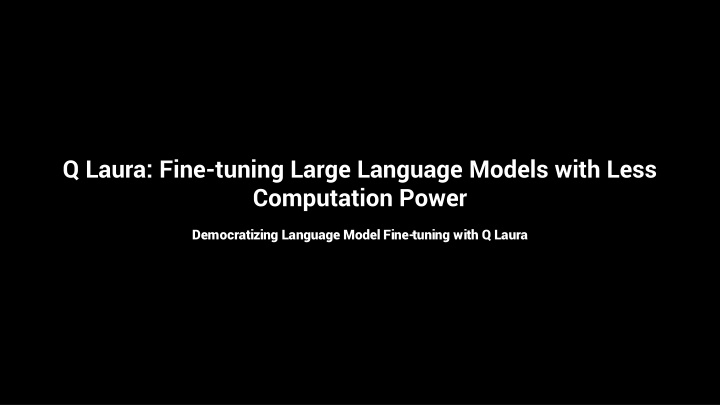
Q Laura: Fine-tuning Large Language Models with Less Computation Power
"Discover how Q Laura revolutionizes fine-tuning of large language models by creating new weight matrices, enabling training on a single GPU, and achieving impressive performance levels. Learn about the benefits, comparison with traditional fine-tuning, and training techniques with Transformers and Bits and Bytes libraries."
Download Presentation

Please find below an Image/Link to download the presentation.
The content on the website is provided AS IS for your information and personal use only. It may not be sold, licensed, or shared on other websites without obtaining consent from the author. If you encounter any issues during the download, it is possible that the publisher has removed the file from their server.
You are allowed to download the files provided on this website for personal or commercial use, subject to the condition that they are used lawfully. All files are the property of their respective owners.
The content on the website is provided AS IS for your information and personal use only. It may not be sold, licensed, or shared on other websites without obtaining consent from the author.
E N D
Presentation Transcript
Q Laura: Fine-tuning Large Language Models with Less Computation Power Democratizing Language Model Fine-tuning with Q Laura
Introduction Q Laura enables fine-tuning of large language models with less computation power Q Laura creates new weight matrices while freezing pre-trained weights Results in a smaller file size after fine- tuning without compromising performance tuning Q Laura allows training large models on a single single GPU with 48GB memory Photo by Pexels Photo by Pexels
Q Laura vs. Traditional Fine-tuning Traditional fine-tuning involves fine-tuning the the entire set of weights Q Laura creates new update matrices while freezing pre-trained weights Pre-trained weights' output activations are augmented by the new update matrices Results in a smaller file size after fine-tuning without compromising performance Photo by Pexels Photo by Pexels
Benefits of Q Laura Train a 65 billion parameter model on just a single single GPU with 48GB memory Preserve full 16-bit fine-tuning performance performance Reaches 99% performance level of Charge GPT with 24 hours of fine-tuning Exciting innovation for democratizing large language model fine-tuning Photo by Pexels Photo by Pexels
Training with Transformers and Bits and Bytes Use Transformers and Bits and Bytes libraries for training Install required libraries: Transformers, Bits and Bytes, Pfift, and Datasets Load existing model using AutoTokenizer and AutoModel for causal LM Specify Bits and Bytes configuration for quantization Photo by Pexels Photo by Pexels
Preparing the Model for Training Prepare the model for training using 'prepare_model_for_kbit_training' Enable gradient checkpointing for the model Define Lora configuration for fine-tuning Specify the rank factor, target module, and task for the model Photo by Pexels Photo by Pexels
Training the Model Load the training dataset and instantiate the Transformer trainer class Specify training arguments and output directory Train the model using the instantiated trainer Monitor training progress and loss values Photo by Pexels Photo by Pexels
Using the Fine-Tuned Model Save the fine-tuned model locally Load the model using the loader configuration Combine the base model with the Lora configuration Use the model for inference and generation Photo by Pexels Photo by Pexels
Conclusion Q Laura revolutionizes fine-tuning of large language models Democratizes the process with reduced computation requirements Explore Q Laura models on Hugging Face Model Hub Try fine-tuning your own models using the provided Google Colab notebook Photo by Pexels Photo by Pexels
